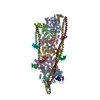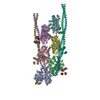[English] 日本語
 Yorodumi
Yorodumi- PDB-7tit: Cardiac thin filament decorated with regulatory M-domain of cardi... -
+ Open data
Open data
- Basic information
Basic information
| Entry | Database: PDB / ID: 7tit | |||||||||
|---|---|---|---|---|---|---|---|---|---|---|
| Title | Cardiac thin filament decorated with regulatory M-domain of cardiac myosin binding protein C | |||||||||
 Components Components |
| |||||||||
 Keywords Keywords | MOTOR PROTEIN / cardiac contraction regulator / muscle protein | |||||||||
| Function / homology |  Function and homology information Function and homology informationC zone / regulation of muscle filament sliding / striated muscle myosin thick filament / cardiac myofibril / actin-myosin filament sliding / regulation of striated muscle contraction / positive regulation of ATP-dependent activity / Striated Muscle Contraction / A band / ventricular cardiac muscle tissue morphogenesis ...C zone / regulation of muscle filament sliding / striated muscle myosin thick filament / cardiac myofibril / actin-myosin filament sliding / regulation of striated muscle contraction / positive regulation of ATP-dependent activity / Striated Muscle Contraction / A band / ventricular cardiac muscle tissue morphogenesis / structural constituent of muscle / myosin binding / sarcomere organization / heart contraction / myosin heavy chain binding / ATPase activator activity / heart morphogenesis / cardiac muscle contraction / titin binding / sarcomere / actin filament / actin filament organization / actin binding / cell adhesion / identical protein binding / metal ion binding / cytosol Similarity search - Function | |||||||||
| Biological species |  Homo sapiens (human) Homo sapiens (human) | |||||||||
| Method | ELECTRON MICROSCOPY / helical reconstruction / cryo EM / Resolution: 8 Å | |||||||||
 Authors Authors | Risi, C.M. / Galkin, V.E. | |||||||||
| Funding support |  United States, 2items United States, 2items
| |||||||||
 Citation Citation |  Journal: J Mol Biol / Year: 2022 Journal: J Mol Biol / Year: 2022Title: Cryo-Electron Microscopy Reveals Cardiac Myosin Binding Protein-C M-Domain Interactions with the Thin Filament. Authors: Cristina M Risi / Edwin Villanueva / Betty Belknap / Rachel L Sadler / Samantha P Harris / Howard D White / Vitold E Galkin /  Abstract: Cardiac myosin binding protein C (cMyBP-C) modulates cardiac contraction via direct interactions with cardiac thick (myosin) and thin (actin) filaments (cTFs). While its C-terminal domains (e.g. C8- ...Cardiac myosin binding protein C (cMyBP-C) modulates cardiac contraction via direct interactions with cardiac thick (myosin) and thin (actin) filaments (cTFs). While its C-terminal domains (e.g. C8-C10) anchor cMyBP-C to the backbone of the thick filament, its N-terminal domains (NTDs) (e.g. C0, C1, M, and C2) bind to both myosin and actin to accomplish its dual roles of inhibiting thick filaments and activating cTFs. While the positions of C0, C1 and C2 on cTF have been reported, the binding site of the M-domain on the surface of the cTF is unknown. Here, we used cryo-EM to reveal that the M-domain interacts with actin via helix 3 of its ordered tri-helix bundle region, while the unstructured part of the M-domain does not maintain extensive interactions with actin. We combined the recently obtained structure of the cTF with the positions of all the four NTDs on its surface to propose a complete model of the NTD binding to the cTF. The model predicts that the interactions of the NTDs with the cTF depend on the activation state of the cTF. At the peak of systole, when bound to the extensively activated cTF, NTDs would inhibit actomyosin interactions. In contrast, at falling Ca levels, NTDs would not compete with the myosin heads for binding to the cTF, but would rather promote formation of active cross-bridges at the adjacent regulatory units located at the opposite cTF strand. Our structural data provides a testable model of the cTF regulation by the cMyBP-C. | |||||||||
| History |
|
- Structure visualization
Structure visualization
| Structure viewer | Molecule:  Molmil Molmil Jmol/JSmol Jmol/JSmol |
|---|
- Downloads & links
Downloads & links
- Download
Download
| PDBx/mmCIF format |  7tit.cif.gz 7tit.cif.gz | 525.1 KB | Display |  PDBx/mmCIF format PDBx/mmCIF format |
|---|---|---|---|---|
| PDB format |  pdb7tit.ent.gz pdb7tit.ent.gz | 430.6 KB | Display |  PDB format PDB format |
| PDBx/mmJSON format |  7tit.json.gz 7tit.json.gz | Tree view |  PDBx/mmJSON format PDBx/mmJSON format | |
| Others |  Other downloads Other downloads |
-Validation report
| Summary document |  7tit_validation.pdf.gz 7tit_validation.pdf.gz | 799.9 KB | Display |  wwPDB validaton report wwPDB validaton report |
|---|---|---|---|---|
| Full document |  7tit_full_validation.pdf.gz 7tit_full_validation.pdf.gz | 1.5 MB | Display | |
| Data in XML |  7tit_validation.xml.gz 7tit_validation.xml.gz | 193.7 KB | Display | |
| Data in CIF |  7tit_validation.cif.gz 7tit_validation.cif.gz | 275 KB | Display | |
| Arichive directory |  https://data.pdbj.org/pub/pdb/validation_reports/ti/7tit https://data.pdbj.org/pub/pdb/validation_reports/ti/7tit ftp://data.pdbj.org/pub/pdb/validation_reports/ti/7tit ftp://data.pdbj.org/pub/pdb/validation_reports/ti/7tit | HTTPS FTP |
-Related structure data
| Related structure data |  25914MC  7tijC  7tj7C M: map data used to model this data C: citing same article ( |
|---|---|
| Similar structure data | Similarity search - Function & homology  F&H Search F&H Search |
- Links
Links
- Assembly
Assembly
| Deposited unit | 
|
|---|---|
| 1 |
|
- Components
Components
| #1: Protein | Mass: 41830.551 Da / Num. of mol.: 6 / Source method: isolated from a natural source / Source: (natural)  #2: Protein | Mass: 24803.123 Da / Num. of mol.: 6 Source method: isolated from a genetically manipulated source Details: only triple helix motif from C1-M construct bound to thin filament is visible in the map and contained in the model Source: (gene. exp.)  Homo sapiens (human) / Gene: MYBPC3 / Production host: Homo sapiens (human) / Gene: MYBPC3 / Production host:  #3: Protein | Mass: 11507.176 Da / Num. of mol.: 4 / Source method: isolated from a natural source / Source: (natural)  |
|---|
-Experimental details
-Experiment
| Experiment | Method: ELECTRON MICROSCOPY |
|---|---|
| EM experiment | Aggregation state: HELICAL ARRAY / 3D reconstruction method: helical reconstruction |
- Sample preparation
Sample preparation
| Component | Name: Complex of cardiac thin filament with C1-M fragment of cardiac myosin binding protein C (cMyBP-C) Type: COMPLEX Details: Only triple helix motif of the M-domain is visible in the map. C1 domain is not bound and hence not visible in the map. Entity ID: all / Source: MULTIPLE SOURCES |
|---|---|
| Molecular weight | Experimental value: NO |
| Buffer solution | pH: 7 |
| Specimen | Embedding applied: NO / Shadowing applied: NO / Staining applied: NO / Vitrification applied: YES |
| Specimen support | Grid material: COPPER / Grid mesh size: 300 divisions/in. / Grid type: PELCO Ultrathin Carbon with Lacey Carbon |
| Vitrification | Instrument: FEI VITROBOT MARK IV / Cryogen name: ETHANE / Humidity: 100 % / Chamber temperature: 275 K |
- Electron microscopy imaging
Electron microscopy imaging
| Experimental equipment |  Model: Titan Krios / Image courtesy: FEI Company |
|---|---|
| Microscopy | Model: FEI TITAN KRIOS |
| Electron gun | Electron source:  FIELD EMISSION GUN / Accelerating voltage: 300 kV / Illumination mode: FLOOD BEAM FIELD EMISSION GUN / Accelerating voltage: 300 kV / Illumination mode: FLOOD BEAM |
| Electron lens | Mode: BRIGHT FIELD / Nominal defocus max: 3500 nm / Nominal defocus min: 1000 nm |
| Specimen holder | Cryogen: NITROGEN / Specimen holder model: FEI TITAN KRIOS AUTOGRID HOLDER |
| Image recording | Electron dose: 34 e/Å2 / Film or detector model: GATAN K3 (6k x 4k) |
- Processing
Processing
| Software | Name: PHENIX / Version: 1.18.2_3874: / Classification: refinement | ||||||||||||||||||||||||||||||||||||
|---|---|---|---|---|---|---|---|---|---|---|---|---|---|---|---|---|---|---|---|---|---|---|---|---|---|---|---|---|---|---|---|---|---|---|---|---|---|
| EM software |
| ||||||||||||||||||||||||||||||||||||
| CTF correction | Type: PHASE FLIPPING AND AMPLITUDE CORRECTION | ||||||||||||||||||||||||||||||||||||
| Helical symmerty | Angular rotation/subunit: -166.7 ° / Axial rise/subunit: 27.4 Å / Axial symmetry: C1 | ||||||||||||||||||||||||||||||||||||
| 3D reconstruction | Resolution: 8 Å / Resolution method: FSC 0.143 CUT-OFF / Num. of particles: 14282 / Algorithm: BACK PROJECTION / Symmetry type: HELICAL | ||||||||||||||||||||||||||||||||||||
| Atomic model building | Protocol: FLEXIBLE FIT / Space: REAL | ||||||||||||||||||||||||||||||||||||
| Atomic model building | 3D fitting-ID: 1 / Source name: PDB / Type: experimental model
| ||||||||||||||||||||||||||||||||||||
| Refine LS restraints |
|
 Movie
Movie Controller
Controller




 PDBj
PDBj









